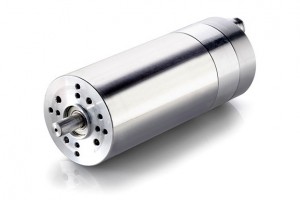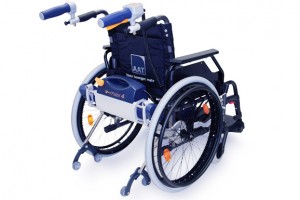Steep inclines or ramps shouldn’t pose an obstacle to wheelchair users or the people who help push them. The v-max 4 pushing and braking aid from AAT Alber Antriebstechnik GmbH provides a helping hand here. Whether uphill or downhill, the drive accelerates or slows the wheelchair wherever it goes.
One of the great advantages of the v-max 4 pushing and braking aid from AAT is that it can be retrofitted to virtually all common wheelchairs. A manual wheelchair can be converted in no time. The battery is placed under the seat cover and has a range of up to 24 kilometres. The manual wheelchair wheels are replaced with AAT’s special sprocket wheels. The gear wheels on the drive shafts of the v-max 4 interlock in the sprocket and transfer the drive or braking forces directly to the wheels.
The drive unit is inserted in a special holder behind the wheelchair’s backrest and connected to the battery. All that is left is to move the ergonomic control handles into position and the user can hit the road. The user can engage and disengage the system and control the drive at the touch of a button with the help of an integrated display.
Maximum power, minimum size
The v-max 4 pushing and braking aid is powered by ECI 63 series motors from ebm-papst. They are light, compact, powerful and dynamic – perfect for the requirements AAT has for its drive units.
ECI 63 modular system
 Modern miniature drives for automation, laboratory, medical or packaging technology often have to perform highly individual tasks. A new approach when building drive systems equipped for a specific application has been developed by the drive system experts at ebm-papst St. Georgen. Individual modular subgroups can be configured and assembled to form a drive system according to a requirements profile specified by the user. The first motor option available is the version ECI 63 with best values for rated output of up to 400 W and 1000 mNm plus an motor efficiency of almost 90% with just 63 mm diameter.
Modern miniature drives for automation, laboratory, medical or packaging technology often have to perform highly individual tasks. A new approach when building drive systems equipped for a specific application has been developed by the drive system experts at ebm-papst St. Georgen. Individual modular subgroups can be configured and assembled to form a drive system according to a requirements profile specified by the user. The first motor option available is the version ECI 63 with best values for rated output of up to 400 W and 1000 mNm plus an motor efficiency of almost 90% with just 63 mm diameter.
Also excellent are the motors’ long service life and resistance to wear. The electronic control means that the EC motors can be perfectly commutated. This helps the wheelchairs master even steep inclines. The small dimensions and low weight make transport easier and increase the range.
“The pushing and braking aid aims to make life easier for patients and their carers”, explains Philipp Rauch, Sales Executive for industrial drive engineering at ebm-papst St Georgen. “This is exactly what our dynamic drives do, even under difficult conditions like extreme temperatures, steep inclines or high patient weight.”
Proven cooperation
AAT and ebm-papst have been working together on useful everyday aids for wheelchair users since 2004. Their list of developments includes an electric auxiliary drive that has all the advantages of a self-propelled drive system but can also be used as a pushing and braking aid.
Other developments in over a decade of cooperation include electric auxiliary drives for manual wheelchairs that help people who are obese or have limited mobility travel independently. Important factors for the engineers are the range of the battery, the weight of the complete drive unit and the functionality. These are important because they are designing a product that gives people precious freedom and independence.


Leave a comment